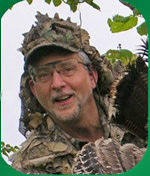Gobblers Guns, Chokes, Sights, & Loads
by Ed Migale
There is an old saying that goes something like this: a good
gunner can get game with just about any gun; but with a good
gun a good gunner can get his game most any time.
Like a lot of old sayings, there may be some truth hidden amidst the riddle. Certainly, the wingshooter whose smoothbore is fitted to his physique is at an advantage because the gun will shoot to where he looks. And the big game hunter or long range marksman whose rifle is tuned and set to shoot custom-tailored handloads is apt to score consistently tight groups.
But what of turkey hunters? Any old shotgun will do for these huge birds we shoot walking on the ground, rather than flying swiftly through the air, won’t it?
Well … maybe … and maybe not.
Now don’t get me wrong as many a turkey has fallen to the duck-gun equipped hunter. However, as specialized a pastime as turkey hunting is, perhaps the hunter could benefit from a specialized gun?
I say “Yes”. Bear in mind I’m not saying you have to go out and spend a bucket full of money on a new gun. In fact, I built my turkey gun on a 1970’s vintage Remington 1100 in 12 gauge, 3 inch magnum, for pennies on the dollar. Here’s what I did:
- Short barrel: I sent my barrel to a company that installs aftermarket choke tubes and had the barrel cut back to 20 ¼ inches. The shorter barrel is more maneuverable while walking through brushy woodlands and when making final adjustments on an approaching gobbler. If the thought of cutting 7 or 8 inches off your gun’s barrel makes you gasp, some firearms manufacturers offer shorter barrels as accessories.
- Extended choke tube: When the barrel was cut back, I had a specialized turkey choke installed. This tube extends past the muzzle of the gun by 1 1/8 inches, elongating the parallel section of the choke and thus improving patterns. The choke is also ported, which according to Charlie Boswell, president and founder of Comp-N-Choke in Sylvania, Georgia, reduces muzzle jump and felt recoil. “The ports also retard the wad just enough so that it lags behind the shot string as it exits the barrel,” said Boswell. “This prohibits the wad from disrupting the pattern.”
- Recoil pad: While most guns have these nowadays, it would be a good idea to install one on your turkey gun if it is not so equipped. Killing a turkey requires a dense shot pattern, calling for large payloads of shot. But launching lots of shot means lots of recoil, which can be unpleasant. And since normal human beings tend to avoid unpleasant sensations, excessive recoil can cause flinching … and missing!
- Sights: Shotguns are normally pointed at then swung through moving targets, while the shooter – both eyes open -- focuses on the target, not on the gun’s bead. The bead is not a sight; it is designed to be a point of reference. But in turkey hunting, we aim our shotgun at a stationary target: the turkey’s head/neck region. The standard bead is inappropriate for this duty, because it does not allow for a joining of the horizontal and vertical alignment of the gun’s bore with the intended target. This is why a turkey gun needs some sort of sight. I started out with rifle sights clamped to the gun’s rib, but changed over to a 1 power scope a few years ago. The crosshairs of the scope are easy to place on the spot I want the center of my pattern to go and at 1 (or “zero”) power, there is no magnification to cause ranging difficulties.
- Raised comb: If you take Ed’s advice and put a sighting device on your turkey gun, you will have to raise the gun’s comb (that portion of the stock where your cheek rests) in order to align your eye with the sight and target. There are commercially available kits for this, but I simply taped layers of neoprene from old waders to the stock until I had perfect alignment.
- Camo finish: Turkey guns, like turkey hunters, should be completely camouflaged. There are tapes and nettings available, but I like spray paint. Start by sanding the gun’s exterior, then applying a primer. To get the best 3-D effect, begin with a light tan color as a base layer, then apply slightly darker tones of browns, grays, greens and finally, just a touch of black to replicate shadows. Use of an oak leaf shaped stencil will give your paint job a professional look, just don’t forget to mask the sights! Carry-Strap: Since you’ll carry a turkey gun a whole lot more than you’ll shoot it, attach a carry strap which will free both hands to operate friction calls or scan open hillsides with a binocular.
- Loads: OK you’ve turned that semi-retired pawn shop special into a fully dedicated, highly specialized turkey hunting gun. So what do you feed it? “Every barrel is an individual,” noted Charlie Boswell, “so I suggest that hunters try patterning several different loads and at least two different shot sizes in order to determine what their gun likes.” Boswell likes either copper or nickel plated lead #4’s and #5’s. I like nickel-plated #5’s. For the last few years, I’ve been shooting a two ounce roll-crimped handload using a “Turkey Ranger” wad and recipe from Ballistic Products of Corcoran, Minnesota. This load delivers good patterns out to 45 yards with surprisingly mild recoil.
Turkey hunting – set in the spring woods and focused on one of nature’s most alert creatures -- is unlike any other type of hunting. Shouldn’t your gun be as specialized and unique as this fascinating and challenging endeavor?
Sources: Ballistic Products (888) 273-5623 www.ballisticproducts.com Comp-N-Choke (888) 875-7906 www.comp-n-choke.com
